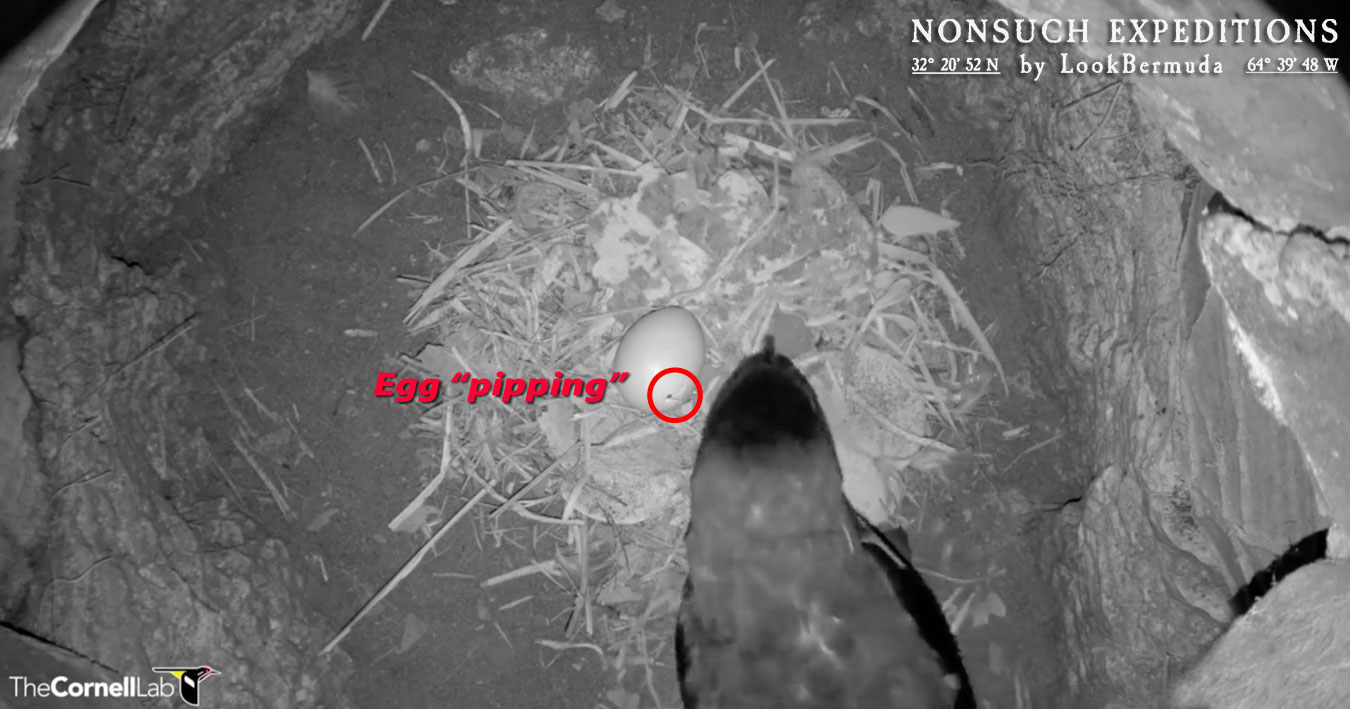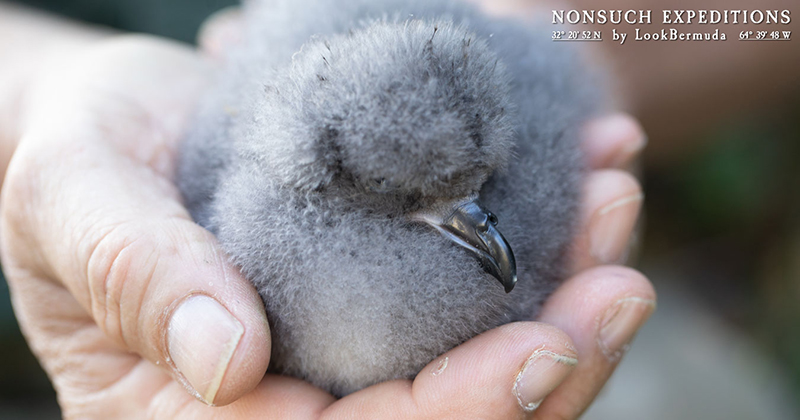“Hatching Alert” For Online CahowCam 2
The Cahow egg being watched by the online CahowCam 2 is on “hatching alert,” with hatching expected to take place in the next 7-10 days.
A spokesperson said, “During the night of March 8-9, there began to be indications that the egg being incubated by the adult female Cahow [band no. E0172] in the CahowCam 2 nest [nest burrow no. R832] was beginning to hatch. The adult began to act broody, looking under itself and checking the egg frequently, while partly spreading its wings, while a faint cheeping was occasionally heard.
“This shows that the hatching process has probably begun, and a check of the laying date shows that the egg was laid about 51-52 days ago, so this is right about on schedule. The chick often starts peeping a few days before hatching begins, and the adult knows that hatching is imminent.
“The chick will first go into drawdown, then breaking through the inner membrane into the air cell inside the egg. This is called internal pipping. [Thanks to research associate Carla Marquardt for clarifying the hatching sequence].
“Using contractions of its egg muscles, the chick starts tapping its bill against the eggshell, with a small, horn-like structure on the end of the bill causing dimple-like punctures or cracks in the big end of the eggshell.
“This is called external pipping, and once the chick starts to breath external air through these dimple cracks, this encourages it to make more. This goes on until there are enough of these cracks to weaken the shell so that the chick can push against and pop off the end of the eggshell. The adult keeps the egg/chick warm during this process, which can go on for as long as eight to 48 hours.
“After the wet, exhausted chick finally gets out of the eggshell, the adult preens it and then broods it, so that it can rest and dry out. When the chick emerges several hours later, it has magically transformed and looks much larger with its thick layer of down now fluffed out. The adult will often feed the chick within five hours with the last of its own food reserves.
“After one to three days of brooding the newly hatched chick, the adult will leave it to return to sea to forage for squid, fish and crustaceans to bring back and feed the chick. These feeding trips can last three to five days or more, covering up to several thousand miles. Both adults will devote the next three months to feeding the chick, often loosing up to 40% of their own body weight in the process.
“Elsewhere throughout the colony, the 2021 Cahow nesting season is progressing well, with chick hatching proceeding somewhat ahead of schedule after an earlier than usual start.”
Jeremy Medeiros, Chief Terrestrial Conservation Officer, said, “Following visits to the two eastern nesting islands on Friday, March 5, and two of the three western nesting islands on Saturday, March 6, I can confirm that the number of hatched Cahow chicks now exceeds 40.
“A tenth Cahow chick was confirmed as having hatched on Nonsuch Island, with another egg in the process of hatching, and three more viable eggs still being incubated. Meanwhile, on Horn Rock, a total of 16 hatched chicks were confirmed on Saturday, with nine more viable eggs still being incubated. The other chicks are spread out between three other nesting islands.
“A good number of eggs are still being incubated by adult Cahows on all islands, and eggs can continue to hatch right up to the 18th to 21st of March, depending on how late they were laid. The first hatched chick was confirmed on the 23rd of February, one of the earlier hatchings on record. Weighing and growth measurements of hatched chicks have already been started, and I am happy to report that chicks are receiving regular feeding visits by adults, with some chicks measured today having increased from their 38 – 43 gram hatch weights to as much as 112 – 126 grams already.
2021 Cahow chick from neighboring burrow in Nonsuch Cahow Colony A – [Photo courtesy of J-P Rouja]
“My prior visits in the last few days of February saw a record number of early Cahow chick hatchings, with at least 15 chicks having been confirmed as hatching on the Castle Harbour Nesting Islands by the 28th of February. Normally, only three to five chicks hatch by this date, so things seem to be ahead of schedule with the Cahow breeding season.
“Much the same is also true with Bermuda’s breeding population of White-tailed Tropicbirds, or Longtails as they are universally known in Bermuda, with literally hundreds of them visiting nest sites in the Castle Harbour Islands and elsewhere in Bermuda during the last week of February.
“For example, on Thursday 25th February, when I visited Nonsuch Island, five of the six artificial Tropicbird nests along the stairway leading up from the dock had adult Tropicbirds peering warily at me from the nest entrances. In a normal year, Tropicbirds are not normally visiting nests until mid to late March, so things are definitely running early with both species.
“This has had the effect of having to rush to finish re-installing the entrance baffles on all Cahow nests that prevent the more aggressive Tropicbirds from invading and taking over the nests, and killing the chicks. In the earliest years of the Cahow recovery program, almost 75% of Cahow chicks were being killed by Tropicbirds during nest invasions.
CahowCam1 Egg Failure, Feb 28
“Since the baffles were developed, with specially-sized entrances that allow the slightly smaller Cahows to enter but keep the larger Tropicbirds out, there have been almost no chick deaths due to this cause.
“These baffles are taken out during the first stage of the breeding season, when the Tropicbirds are still out at sea, to make it easier for returning young Cahows to prospect for and find nests, and also to allow the female birds carrying large eggs on the verge of laying to enter the nests without restriction.
“We are now able to confirm what we had suspected for some time, that the egg in the CahowCam 1 nest on Nonsuch Island had failed and will not be hatching this year. Although this may be upsetting for some people, most pairs of Cahows only successfully produce chicks every other year, so as this pair did successfully produce a chick [named Nemo] in 2020, they are about average in their breeding success rate.
CahowCam 2 Health Check, Feb 28
“At present, the egg being incubated in the CahowCam 2 nest is fertile and developing well, and should hopefully be hatching in the next 7-10 days. On Friday 5th March, I finished installing the entrance baffles, after which I carried out quick nest checks on Nonsuch Island and a couple of the other nesting islands.
“I was overjoyed to record nine Cahow chicks already having hatched at the “A” Cahow nesting colony on Nonsuch, with several more eggs still being incubated by adult birds. [I did not have time to check the second "B" colony site on Nonsuch, so we may also have one or two chicks there as well].
“Overall, almost 30 chicks have already hatched on all nesting islands, so in the next two weeks, as hatching continues, we should know the total number of Cahow chicks produced this year by the breeding population. At the moment, it looks like there is still a good chance of beating the record of 73 successfully fledged chicks produced in 2019.
“This is the ninth season LookBermuda’s Nonsuch Expeditions have been streaming live from the underground nesting burrows on Nonsuch Island, the last few in collaboration with the Cornell Lab of Ornithology, during which over 40 million minutes of video has been watched over the years.
“Sign up for newsletter and nesting alerts and watch live now.”
Read More About
Category: All, Environment





